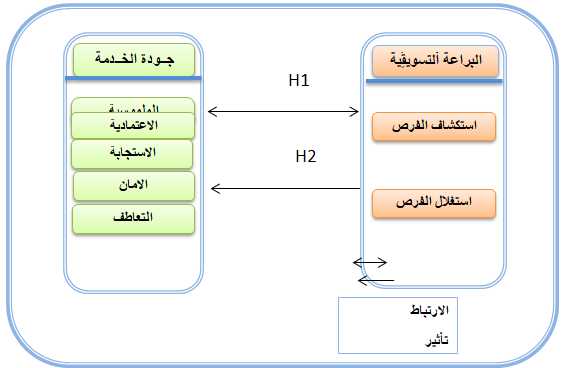تأثير البراعة التسويقية في تحسين جودة الخدمة
بحث تحليلي لآراء عينة من العاملين في مستشفى الكفيل التخصصي في محافظة كربلاء المقدسة
الكلمات المفتاحية:
البراعة التسويقية، جودة الخدمةالملخص
يهدف البحث الحالي الى تقصي تأثير البراعة التسويقية في تحسين جودة الخدمة. وقد جرى اختيار عينة من العاملين في مستشفى الكفيل التخصصي في محافظة كربلاء المقدسة لأجراء البحث بلــغ حجمها (106 ) عاملاً ، وجرى الاعتماد على مقاييس تجريبية من دراسات سابقة للتحقق من الفرضيات، وذلك عن طريق مجموعة متنوعة من الأدوات والاساليب الإحصائية لتحليل ومعالجة البيانات والمعلومات باستخدام الحزم الإحصائية اللازمة بالتحليل العاملي التوكيدي للتحقق من الصدق البنائي التوكيدي للمقاييس المستخدمة في هذا البحث ، ومصفوفة الارتباط البسيط و معادلة النمذجة الهيكلية لاختبار فرضيــات البــحث وبرنــامج (23 (SPSS vr. ، وبرنامج )23. (Amos vr. وتوصل البحث الى مجموعة من الاستنتاجات اهمها (ادراك ادارة المستشفى المبحوثة بشكل كبير لمتغير جودة الخدمة ، ويظهر ذلك عن طريق امتلاكها تجهيزات طبية ومعدات حديثة ذات مواصفات عالمية لتقديم الخدمة ، فضلا عن اعتمادية خدماتها المقدمة وخاصة فيما يتعلق بتوفير الخدمة الى المرضى بشكل صحيح ودقيق كما معلن عنها ) . وفي ضوء الاستنتاجات صيغت مجموعة من التوصــيات ابرزها (ضرورة تعزيز الاهتمام من قبل إدارة المستشفى المبحوثة بالعاملين فهم المدخل السليم لضمان جودة الخدمة ومصدر رئيس لبناء علاقة طويلة الأمد بين المستشفى ومراجعيها ، باتباع برامج تحفيز تشجيعية ودعم المبدعين منهم ).
المراجع
اولاً: العربية
أحلام ، دريدي ،(2014) ، دور استخدام نماذج صفوف الانتظار في تحسين جودة الخدمات الصحية دراسة حالة المؤسسة العمومية للصحة الجوارية بسكرة ،الجزائر ،رسالة ماجستير ،كلية العلوم الاقتصادية ،جامعة محمد خيضر بسكرة .
بشارة , محمد خليل ,( (2018، دور البراعة التسويقية في تعزيز القدرات التسويقية لمنظمات الاعمال- بحث مقارن في شركات الهاتف النقال العراقية , رسالة ماجستير , كلية الادارة والاقتصاد , جامعة بغداد .
بن عيشاوي ، أحمد ،2013)) ، قياس أبعاد جودة الخدمات من وجهة نظر العملاء: دراسة ميدانية لخدمات الهاتف النقال المقدمة من طرف المؤسسات الثلاث (موبليس، جيزي و أوريدو) بمدينة ورقلة جنوب الجزائر ، مجلة الباحث العدد 14.
البياتي ، محمد مجول شكور ،(2018) ، التنوع الثقافي للموارد البشرية وتأثيره في جودة الخدمة دراسة استطلاعية لآراء عينة من العاملين في فندق بابل الدولي ، رسالة ماجستير ، كلية الادارة والاقتصاد ، جامعة كربلاء .
الذبحاوي ، سناء جاسم محمد ،((2019 ، دور اللوجستيات المرتدة والبراعة التسويقية في تعزيز بهجة الزبون دراسة تحليلية لآراء عينة من زبائن معمل الحصيرة البلاستيكية في الناصرية ، اطروحة دكتوراه ، كلية الادارة والاقتصاد ، جامعة كربلاء .
عابدين ، محمد فوزي سالم ،(2006) ، قياس جودة الخدمات الهاتفية الثابتة التي نقدمها شركة الاتصالات الفلسطينية في محافظات قطاع غزة , رسالة ماجستير كلية التجارة ، الجامعة الإسلامية - غزة .
الكلابي ، امير نعمة مخيف،(2017)، بناء بصيرة الزبون على أساس التسويق الشمولي من خلال البراعة التسويقية ، اطروحة دكتوراه ، كلية الادارة والاقتصاد – جامعة الكوفة.
ثانياً : الأجنبية
Baškarada, S., Watson, J., & Cromarty, J. (2016). Leadership and organizational ambidexterity. Journal of Management Development, 35(6), 778–788.
Du Plooy, T., & De Jager, J. (2007). Measuring tangibility and assurance as determinants of service quality for public health care in South Africa. Professional Accountant, 7(1), 96–111.
El Saghier, N., & Nathan, D. (2013). Service quality dimensions and customers’ satisfactions of banks in Egypt. Proceedings of 20th International Business Research Conference, 13.
Elmayar, A. (2011). Assessing the perceived service quality levels in the Libyan private and public banking sectors: a customer perspective. Northumbria University.
Geetha, R. (2015). AND CONSTITUTIVE ELEMENTS OF AN ENTERPRISE Abstract : 1(1), 1–12.
Harmancioglu, N., Sääksjärvi, M., & Hultink, E. J. (2019). Cannibalize and combine? The impact of ambidextrous innovation on organizational outcomes under market competition. Industrial Marketing Management.
Haynes, K., & Fearfull, A. (2008). Exploring ourselves:: Exploiting and resisting gendered identities of women academics in accounting and management. Pacific Accounting Review, 20(2), 185–204.
Hoffman, K. D., & Bateson, J. E. G. (2010). Services marketing: concepts, strategies, & cases. Cengage learning.
Johnson, L. M. (2017). Measurement of service quality and customer satisfaction at a children’s hospital in the Western Cape. Cape Peninsula University of Technology.
Josephson, Brett W, Johnson, J. L., & Mariadoss, B. J. (2016). Strategic marketing ambidexterity: Antecedents and financial consequences. Journal of the Academy of Marketing Science, 44(4), 539–554.
Josephson, Brett William. (2014). The Effect of Marketing Strategy on Firm Financial Performance.
Kline, R. B. (2011). Principles and practice of structural equation modeling (3rd ed.). Guilford publications.
Marakanon, L., & Panjakajornsak, V. (2017). Perceived quality, perceived risk and customer trust affecting customer loyalty of environmentally friendly electronics products. Kasetsart Journal of Social Sciences, 38(1), 24–30.
March, J. G. (1991). Exploration and exploitation in organizational learning. Organization Science, 2(1), 71–87.
Mudie, P., & Pirrie, A. (2012). Services marketing management. Routledge.
Parasuraman, A., Zeithaml, V. A., & Berry, L. L. (1988). Servqual: A multiple-item scale for measuring consumer perc. Journal of Retailing, 64(1), 12.
PENG, Z., HE, P., & LI, Z. (2015). Strategic Orientations, Ambidextrous Marketing Activities and Service Firm Performance: The Moderating Role of Market Competitive Intensity. Economic Management Journal, 6, 11.
Phillip, K., & Keller, K. L. (2012). Marketing Management 14th edition Jakarta: PT. Indeks Kelompok Gramedia.
Polyakova, O., & Mirza, M. (2015). Perceived service quality models: Are they still relevant? The Marketing Review, 15(1), 59–82.
Purcărea, V. L., Gheorghe, I. R., & Petrescu, C. M. (2013). The assessment of perceived service quality of public health care services in Romania using the SERVQUAL scale. Procedia Economics and Finance, 6, 573–585.
Shabbir, A., Malik, S. A., & Janjua, S. Y. (2017). Equating the expected and perceived service quality. International Journal of Quality & Reliability Management.
Smith, W. K., & Tushman, M. L. (2005). Managing strategic contradictions: A top management model for managing innovation streams. Organization Science, 16(5), 522–536.
TOKGÖZ, E., AKATAY, A., & ÖZDEMİR, S. (2017). Impact Of Ambıdextrous Marketıng On Market And Fınancıal Performance. KnE Social Sciences, 1(2), 59. https://doi.org/10.18502/kss.v1i2.647
Vorhies, D. W., Orr, L. M., & Bush, V. D. (2011). Improving customer-focused marketing capabilities and firm financial performance via marketing exploration and exploitation. Journal of the Academy of Marketing Science, 39(5), 736–756.
Wilson, A., Zeithaml, V., Bitner, M. J., & Gremler, D. (2016). Services marketing: Integrating customer focus across the firm.
Xu, H., Feng, Y., & Zhou, L. (2016). Market Knowledge Development of Indigenous Chinese Firms for Overseas Expansion: Insights from Marketing Ambidexterity Perspective. In Asian Businesses in a Turbulent Environment (pp. 115–141). Springer.
Yang, T., & Li, C. (2011). Competence exploration and exploitation in new product development. Management Decision.
Zeithaml, V. A., Bitner, M. J., Gremler, D. D., & Pandit, A. (2018). Services marketing: Integrating customer focus across the firm. Irwin/McGraw-Hill Boston.

التنزيلات
منشور
كيفية الاقتباس
إصدار
القسم
الرخصة
الحقوق الفكرية (c) 2024 فؤاد حمودي العطار، اسامة حمزة عبود المعموري

هذا العمل مرخص بموجب Creative Commons Attribution-NonCommercial-NoDerivatives 4.0 International License.
يحتفظ المؤلفون بحقوق الطبع والنشر لأوراقهم دون قيود.









